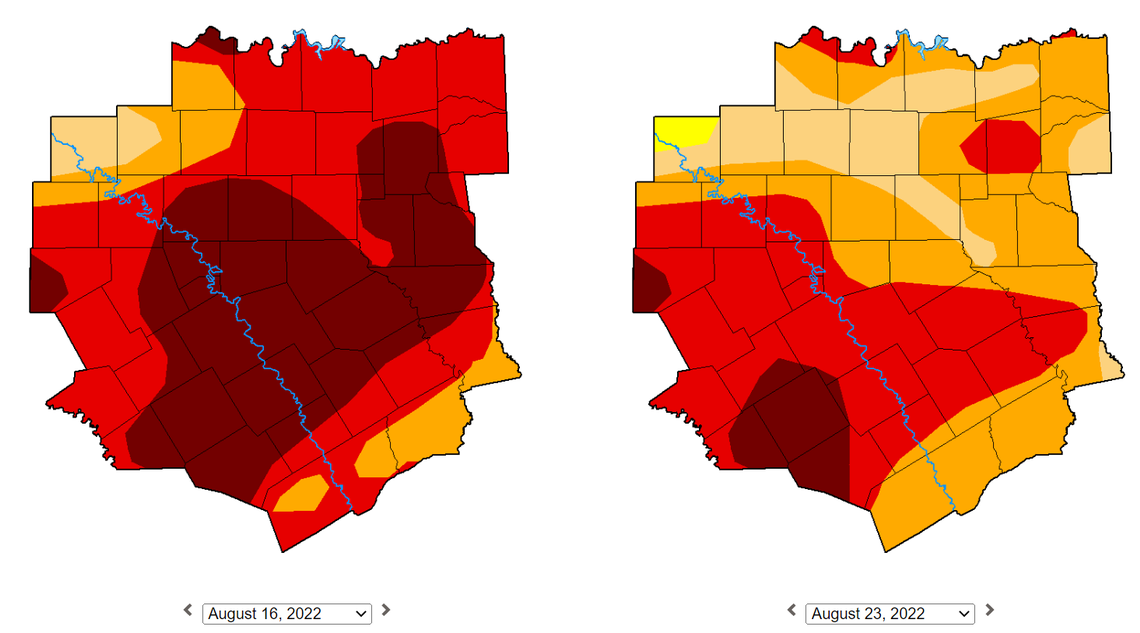Record rainfall this month a good start in getting Texas out of the drought
The rain that poured on Dallas-Fort Worth early last week might mean that the drought will finally let up. This month now holds the title of wettest August on record, totaling 10.38 inches of rain. As of Aug. 25, drought conditions in the state are down by 6% in just a week, from 93% to 87%, according to the U.S. Drought Monitor.
Just last week, there had been a precipitation deficit of nearly 17 inches, contributing to a drought on par with that of 2011. That’s increased the risk of crop and livestock losses, sparked wildfires, pushed the power grid to its limit and reduced reservoirs to lower levels. According to the National Weather Service, prior to this week’s rain, the Dallas-Fort Worth Area went 67 days without measurable precipitation, the second longest streak on record going back to 1898.

“Much of north central and northeast Texas got rain in the past week, so that’s had a substantial effect on streamflow, at least temporarily, so we’re getting good amounts of runoff into downstream reservoirs,” state climatologist John Nielsen-Gammon told the Star-Telegram. “Particularly where we have sandy soil, where the water can soak in rapidly, it’s made major improvements for plants and agriculture and ranching as well.”
The percentage of the state experiencing extreme or exceptional drought is about 43% — down by just under 20%. Just two weeks ago, 100% of Tarrant County was in extreme or exceptional drought, and last week, it dropped to 89% in severe drought and 11% in moderate drought.
Still, widespread drought persists, affecting 22.1 million Texans. There are 245 Texas counties with USDA disaster designations and 176 counties with burn bans. And drought conditions overall have worsened in just a few months. Three months ago, drought conditions were at 79%. They were at 67% in December.
Impact of drought improvement
Droughts are among the most costly weather-related events and the most far reaching, according to the National Weather Service.
One of the most dangerous consequences of drought is elevated fire danger, with dry conditions contributing to wildfires across the state this past year. Texas has seen a 40% increase in the number of fires, compared to the annual average. The recent rain may potentially offer a break from fire activity, as it should improve fuel dryness and reduce fire weather, Texas A&M Forest Service said. Rainfall has allowed firefighters to increase containment on several carryover wildfires.
“It should produce a massive decline in number of wildfires,” Nielsen-Gammon said. “Conditions are wet enough now in Eastern Texas and much of North Central Texas that it’ll be much harder for the initial fire ignition, and there won’t be as much dry fuel available. Central and West Central Texas will still have substantial wildfire risk because they’ve missed out on most of the rain so far.”
Drought also causes water shortages, with streams, reservoirs and wells low. Water reservoirs in North Central Texas are operating at 83% capacity, according to the Texas Water Development Board, compared with 99% a year ago. It’s a slight improvement from a week ago, at 82%.
Drought outlook
According to the latest seasonal drought outlook from the Climate Prediction Center, the drought is expected to remain but improve for much of Texas through Nov. 30. For an area to go from one category to another, for instance from severe to moderate drought, it would need three to four inches of rain, according to Nielsen-Gammon. If we receive 1 inch of rain per week over the next two months, we will see continued drought improvement, says National Weather Service meteorologist Victor Murphy.
“We do expect drought conditions to improve more over the coming weeks and months,” Murphy said. “It looks like the DFW Metroplex should see about 1 inch of rainfall in the Wednesday to Friday timeframe of next week. That should at least keep us as status quo with regard to drought, and perhaps improve things slightly as we move into September.”
Going into October, the second wettest month of the year averaging 4.37 inches of rain, we should see even more improvement.
“At this point, additional rain is very beneficial because it allows the water that’s already in the ground to keep soaking deeper rather than evaporating away. It also produces a greater proportion of runoff so that it improves streams and reservoirs,” Nielsen-Gammon said.
